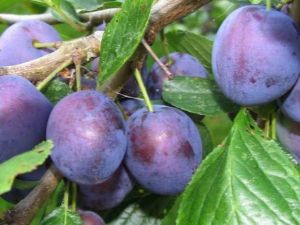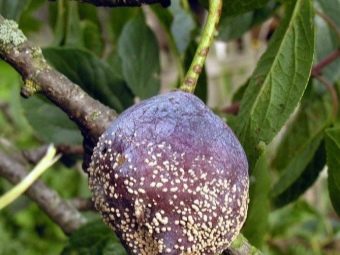Why does not fruit plum and what to do to change the situation?

If the earlier productive plum suddenly ceases to bear fruit, then any gardener will be upset.It is necessary to quickly determine the cause of the trouble and, if possible, eliminate it. There are several basic situations that result in the interruption of the fruiting of this fruit.
What year should give birth?
Generally, if you take care of the plum by the rules, then it begins to yield a crop about 5 years after disembarkation. This period depends on the inherent characteristics of the variety itself, its pollinators and habitat conditions. There is a rule that the first fruits can be expected when the shoots accumulate a specific number of internodes on the kidneys. The process of their appearance can be accelerated by forming a bush.
In addition, in order to understand how to care for a tree so that it quickly becomes fruitful, you need to know which group it belongs to. There are plums that bear fruit at one-year growth (it is important to maintain the growth of shoots), on perennial overgrowing branches (you have to constantly thin out the crown) and intermediate ones (you have to do both).
Even at the stage of buying seedlings should find out whether they will be self-fruitful or self-bearing. In the first case, the plant can only multiply with the help of bees carrying pollen from related plants. Plants should be of a different variety, but ripen at the same time that requires pollination. In the second - own pollen is used, and pollination occurs independently. In the case of plums, preference is recommended to be given in favor of samoplodnyh varieties.
In addition, it is important to understand whether the selected seedlings will be combined with each other, as well as with the existing soil and the existing climate in the area where this fruit is to be grown. The plum will be planted on well-lit beds in such a way that different varieties (if they are available) feel comfortable with each other. If you keep plums in proper conditions, then the harvest can be expected every year.
Finally, it should be borne in mind that this plant can bear fruit for 20 years, after which it will die rather quickly. But some varieties still have lean years, and this is absolutely normal.
The reasons for the lack of fruit
There are eight main reasons why plum does not bear fruit.
First, the fault may be such a nuisance, as the cadaver physiological. Her symptoms are as follows: the tree blooms, ovaries appear, fruits form, but they do not have time to reach a ripe state. Cream just crumble on the ground. Such a defective condition can occur for several reasons: either the drain does not receive enough nutrients, or because of weakness the roots do not cope, or there is an excessive / insufficient amount of moisture, or the wrong care.
Secondly, initially a mistake could be made when choosing a plum variety, and a self-fruitless one was bought (and this is the majority of plum varieties). These varieties need pollinators, and if they are not planted, then the fruits will not have to wait.
In addition, if the plant is planted in a rainy region, the insects responsible for pollination may not cope with the task. In this case, it is better to pick self-bearing varieties.
Thirdly, a fairly common cause is tree diseases. Diseases such as fruit rot and phytosteriasis make it impossible for a plum to form a large amount of fruit. The fungus klyastersporoza destroys the leaves, forming holes in them. Then the infection goes to the branches, stem and cream themselves. Dry and damaged shoots must be cut off, and the plant must be treated three times with special solutions.
In addition, plum can hit monilioz. The plant is covered with black soot and looks like it burned down. As a preventive measure, before the beginning of the appearance of flowers, as well as immediately after it, the cream will need to be processed.
Gray rot strikes the fruits themselves. It should be remembered that the disease calmly endures the cold season and does not disappear due to cold weather.To prevent trouble, the crown and soil will need to be sprayed with a special compound, and the affected fruits with shoots removed and burned.
Fourth, ordinary pests can be to blame. For example, the caterpillar moth eats cream and even seeds: as a result, the fruits fall to the ground and begin to rot. And such a pest as a flower beetle feeds on the buds of flowers and prevents the ovaries from forming.
Fifth, bad weather is becoming quite common. In May, frosts very often occur, and the kidneys freeze, and young shoots are weakened - and the yield drops again. But also a sudden decrease in temperature and cold gusts of wind lead to the sterilization of pollen, without which the appearance of fruits is impossible. Problems also occur in cases of droughts or heavy rains.
During flowering, it is worth paying attention to the pestle - if it froze in the winter, the color will change to black from green. As a result, the fruit will not be able to start.
Sixth, a lot of problems can create the wrong soil. If the soil has increased acidity, then it will be necessary to bring it into a state of "neutrality" - to make additives in the form of ash or slaked lime, chalk, crushed egg shell or limestone flour. The acidity of the soil, by the way, is easily determined by its appearance - if there is a lot of moss and “acid-loving” plants on the surface, but no clover, and a white layer can be seen on the surface, then these figures are clearly increased.
It is important to know that the plum can oxidize the soil in much larger quantities than other trees with shrubs. Therefore, the annual alkalization of the land is necessary.
Seventhly, improper planting of a seedling, in which the root is damaged, can lead to adverse consequences. If the seedling is buried so deeply in the soil that its root collar is not even visible, this will be a big mistake. This part of the plant must necessarily look out.
Eighth, the sink may not have enough lighting. Such a situation may arise if the tree is planted at the fence, the walls of the building, or near the higher "neighbors".
In conclusion, the lack of harvest from the plum can be the result of any mechanical damage, as well as incorrect pruning. In plum, as a rule, the crown is growing strongly, so you need to deal with its formation. Otherwise, the density of the branches will prevent the redirection of resources in flowers and fruits.
What do we have to do?
In general, a complex of measures is always important: feeding, watering, premature protection from pests and diseases. You can only fight with the physiological paladus by conducting preventive measures. During the season it is important to fertilize the plant consistently: in the spring, urea and potassium sulphate are used, and in the summer, when the tree has already bloomed, nitrophoska. All of the above ingredients are diluted in water. At that moment, when the fruits have already begun to form, you can feed the soil chicken droppings, diluted in water. In the autumn it is recommended to take up the roots, again using potassium sulfate, as well as phosphate fertilizers.
To prevent diseases, it is also important to regularly spray a suitable solution, for example, a fungicide. During the appearance of the buds, a month before the harvesting of the fruit and after the leaf fall, spraying is carried out using a Bordeaux solution of different percentages.
In addition, do not forget about the importance of collecting and destroying fallen leaves and mummified fruits.
To force pests to leave the beds can be a variety of activities. These include the active loosening of the soil at the trunk, the installation of traps and the treatment with chemicals, for example, Calypso, Aktara and Mospilan. If the drain does not fit the existing land, then a hole is dug out with sides equal to one meter, which is filled with fertile nutrient mixture. Sometimes only partial improvement is done with peat or sand.
Professional gardeners have now formed several important rules that should be followed. Replace or plant new ones can only be in the spring. Before planting, the wells will ideally be fertilized with organic matter. For example, it can be manure or compost, ash. Of the finished products should choose those that contain potassium salt or superphosphate.
In the first years of the tree’s life, it is recommended to feed it with urea, manure and ash. During a drought, plum should be watered abundantly with liquid, and in order to prevent the negative effects of sunlight and frost, tie stumps and whitewash. Emerging cracks will have to be cleaned and treated with a solution of iron sulphate.
Expert advice
Experts believe that the plum grown from shoots will be quite successful fruit. Moreover, this method of reproduction of this fruit is very simple and convenient. Growth in any case will have to be eliminated in order not to limit the yield of the tree, so it is better to use it with benefit. Deciding to use this method, it is necessary to choose the best process that is far from the trunk. It will be convenient to get him, plus he will already have developed roots. Escape can be dug out either in spring or at the end of summer and early autumn. The size should be average, not exceed 50 centimeters, but also not be less than this size. Small processes are much better adapted to new conditions.
Digging offspring and separate it from the main tree should be very carefully. The growth is taken along with a lump of soil and transferred to a separate container. Immediately you need to moisten the soil and prevent it from drying out. If immediate landing is possible, then you can simply put the plant in a plastic bag.
The root of the main tree is best treated, for example, sprinkle with wood ash.
The resulting shoots should first be planted on a separate bed with nutrient soil and minimal lighting. For about a month, it is necessary to irrigate the plantings abundantly and maintain the optimum temperature. About a month later, the drain should get used to the new place of "residence" - sheets will appear and growth continues. In the same period starts active feeding. Next spring, a stronger plant can be transplanted to a permanent place with good lighting. It is carefully dug and transported along with a clod of earth. The land must be fertile and fertilized.
On ways to combat pests on plums, see the following video.
































